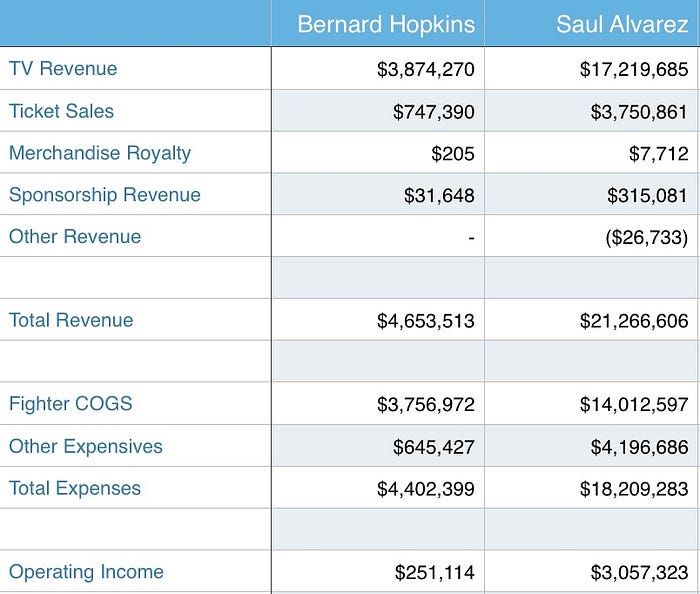While the Golden Boy Promotions (GBP) et al v Al Haymon et al lawsuit is finally over allowing both parties to go about their main business, one residual benefit of the ill-fated lawsuit is that we did get a better look at the finances behind boxing with the reveal of Gene Deetz’s analysis of GBP fighter pay.
While Deetz’s methodology is flawed, it is much more information than the public normally receives, especially when it comes to the fighters who participate in Pay-Per-View bouts. Writers and fans will toss around PPV figures declaring them good or bad without any context as to the actual money being made. Fighters are routinely chastised for poor PPV numbers and are advised to stay on premium cable as the better path.
But what are the realities? Let’s do a comparison on the differences between fighting on premium cable (HBO or Showtime) and fighting on PPV.
Rules of the Bout
The Metrics
For the comparison we will be using Gene Deetz’s analysis of GBP finances. As previously mentioned, there are some flaws in these numbers. GBP keeps their finances on an event-by-event basis and most boxing fans understand that the headliners are the drivers for revenue. However, Deetz spread the figures across all the fighters that appeared on cards using his own formula based on purse and other factors. This method also makes it difficult to reassemble total event revenue when fighters had multiple fights in a given year.
But it will suit our purposes for a fighter income comparison and I’d give the most credence to Fighter COGS. COGS being an accounting term for Cost Of Goods Sold which is what companies determine as the price they need to pay for a product in order to generate revenue from selling said product. In the case of GBP, the product is the boxer and the COGS amount is closer to the real amount of money the boxer makes from their fights.
There’s also the rather nebulous Other Expenses category which I’m assuming contains other payments given to fighters given how it fluctuates between the fighters in Deetz’s figures. Its nature is not as clear as the COGS figure though, something to keep in mind.
The Fighters
For our showdown we will go back to 2014 and compare Bernard Hopkins against Saul “Canelo” Alvarez. In 2014 Bernard Hopkins was GBP’s highest revenue generating premium cable fighter on Deetz’s sheet with a fight on Showtime vs Beibut Shumenov and a fight on HBO against Sergey Kovalev.
While Canelo was GBP’s only contract PPV fighter with two PPV fights against Alfredo Angulo and Erislandy Lara. These PPVs were called disappointing by some in the media with estimated sales ranging from three hundred thousand to three hundred and fifty thousand buys each.
LET’S GET IT ON!

The Winner
It doesn’t take a math professor to see that Saul “Canelo” Alvarez takes this fight in a blowout. After losing to Floyd Mayweather in September of 2013, Canelo decided to bank on himself and his fan support and stayed on PPV. A decision which paid off incredibly not only for him but for GBP as well.
Canelo took a seemingly low guarantee for these fights at $1.25 million for Angulo and $1.5 million for Lara for a combined $2.75 million but as you can see, those numbers are very deceptive in regards to the COGS figure noted in GBP’s expenses at $14,012,597.
So as we approach the idea of Canelo’s PPVs being disappointing we have to ask, disappointing to whom? Canelo fought two fighters who weren’t even popular among the boxing fanbase and made at least $10 million more than GBP’s top cable fighter. And GBP made over twelve times the amount in Operating Income off the two PPVs than they did on the two television fights.
Post-Fight
There are many arguments made against PPV in the boxing world and in future installments we will examine them. But for the boxers, it is clear which path is the one to aim for in the sport. The sport is prize-fighting and PPV holds the biggest prize. Athletic careers are very short and athletes must maximize their earning potential before they are unable to compete. An ending that is also completely unpredictable in a sport like boxing.
And for the promoters, rather than being evidence of greed as many like to portray, the PPVs are usually what funds the entire promotion. Boxing is similar to the music industry where your top performers subsidize your operation while you keep up the search to find the next star to replace them and keep the cycle going. The income from a PPV can provide promoters a lot of cushion for their business.
If the cable companies want fighters to remain on their networks then they have to start paying them on the level they did in decades past. Otherwise they are just asking for fighters to sacrifice their earning potential for the benefit of the networks. A plea which makes little sense for the fighter.